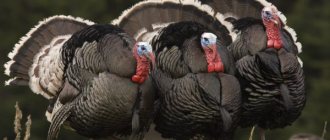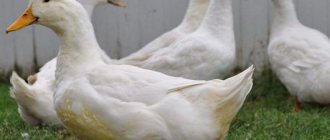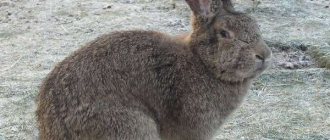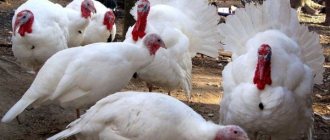Feeding and maintenance
Meals should be taken 3 times a day; overfeeding them is dangerous, since turkeys are genetically prone to obesity. It is necessary to create a diet so that it contains a balanced range of products:
- At the initial stage, starter feeds are used, which allow you to get healthy, young offspring.
- Then grain crops are introduced little by little; in winter, chopped vegetables are always added. Fish oil and rowan are used as vitamins. Dry food can be watered with milk or kefir. And to whet the appetite, finely chopped onions.
- Wheat and oat flour, as well as ground pine needles, will help you gain weight faster.
- Meat and bone meal is used to strengthen bones.
Keeping turkeys is quite expensive; in addition to feed, you will also have to spend money on medicine if the bird gets sick, but after selling the meat, all expenses will be recouped.
Important! You should exclude highly fatty foods from your diet, this will lead to obesity and poor health.
The manger should be made spacious so that the turkey can eat all the food at one time. They must be washed before each meal to avoid infection.
Diseases of turkey poults
Big 6 has a strong immune system, but is susceptible to some dangerous diseases. The most common problem is coccidiosis. This disease is caused by protozoan bacteria and is transmitted from bird to bird through direct contact.
To prevent coccidiosis, the livestock is given metronidazole every month. Newcastle disease is the most dangerous disease for turkeys. This viral disease cannot be cured and is quickly developing into a real epidemic. For prevention, on the first day of life, chicks are given a specialized vaccination, followed by a course of vitamin C. This article will tell you about vitamins for turkey poults.
Growing Big 6 turkey poults
Breeding birds of this breed is not difficult if you follow the prescribed rules. Most often you have to do this from eggs, because it is almost impossible to buy chickens. But their hatchability is very good and reaches 85%, so all the money will be returned with interest. Many farmers try to hatch chicks from the eggs of their turkeys, however, they may not be fertilized.
The question of what time is best to place them in an incubator cannot be answered unequivocally. It all depends on when the meat is needed; you should know that the bird gains its maximum weight in 3-4 months.
For reference!
The eggs must be placed in an already heated incubator; they will remain in it for 28 days.
Fertilization is checked with an ovoscope; the incubation process proceeds in the same way as in chickens. But caring for turkey poults at home requires more patience. Chickens up to a week do not tolerate temperature fluctuations well; 32-35 degrees would be ideal. In this case, it is better for the heat to come from below. During the second week it can be reduced to 27-29.
High temperatures will cause heatstroke or growth retardation in chicks. The most difficult period is up to two months, after which you can put aside all fears, now the chicks will only gain weight.
Most of all, the little turkey is afraid of humidity, so you should not insulate the floor with fabric products, as they instantly absorb moisture. It is better to take hay or dry grass, but it is advisable not to use sawdust, as they get very dirty. In addition, the chicks may begin to peck at them, and thereby carry the infection into their stomach.
What you need to remember when choosing feeders and drinkers for chicks:
- You should wash them before each serving of food.
- It is necessary to install as many nurseries as possible so that the turkey poults do not crowd around them, otherwise some will be malnourished, as a result of which they will begin to lose weight.
- Choose wide drinking bowls; they must also be carefully secured so that the chicks do not overturn the water on themselves. A wet chicken can catch a cold and die; even if you save it, it will still not grow well.
- It is strictly forbidden to use metal feeders, as this may damage the turkey's beak.
They are accustomed to such containers slowly and systematically.
Review of breeds of egg-laying chickens with photographs and descriptions
Breeding chickens begins with the selection of breeds, which are divided into egg-laying and meat-laying. Name of the breed...
Egg production of turkeys
To obtain eggs from a turkey and successfully breed offspring, you will need one male for ten females. The turkey must be one month older than the turkeys. During mating, the male behaves quite aggressively, so to prevent him from injuring his partner, his claws are cut. Fertilization of a turkey usually occurs the first time.
In the first days of laying, you can get one egg from a laying hen in a few days. After some time, turkeys lay eggs every other day or once a day. Each turkey egg weighs about 70–80 grams. The turkey egg itself has a light beige color and brown spots, and its shell is pockmarked.
What egg production a laying hen will have in a year at home depends on many indicators. These include:
- Weight and breed of bird.
- In the spring, turkeys lay eggs better than in the fall.
- The hen must live in peace and quiet, otherwise she can be scared away.
- Dampness and cold have a negative impact on turkey egg laying. The poultry house should always be dry and warm.
- Daylight should be at least ten hours a day.
- Quality and quantity of feed consumed.
When all the conditions necessary for keeping the bird are met, the laying hen’s egg production reaches 120–150 eggs per year . Young females produce small testicles, but in larger quantities. As the turkey ages, the weight of the egg increases, however, it lays eggs less frequently. It has a bad effect on egg production and the molting period.
The eggs received from the female must be collected and stored at home at a temperature of +13 to +18 degrees for no more than ten days. As soon as there are from 11 to 20 turkey eggs, they will need to be placed under the laying hen.
Possible problems
Despite the fact that turkeys are very good hens, some of them categorically refuse to hatch eggs. Turkeys may refuse to perch for several reasons:
- experienced stress;
- health problems;
- reluctance to get used to the new nest;
- poor living conditions and food.
What to do in this case and can turkeys be used as hens? If there are not enough females, many farmers use turkeys to hatch the eggs . The male is placed in the nest on an egg and covered with a basket. After a few days, the basket is removed, and if the turkey remains in place, it is used as a hen. Males that fly out of the nest will not hatch their offspring.
Breeding Features
What you need to know:
- Females begin laying eggs at 9 months. This process lasts at least 24, sometimes up to 32 weeks.
- Turkeys of the medium and light subtype demonstrate the best fertilization rates - from 80 to 90%. Hatching of chicks is about 75%.
- It is advisable to artificially inseminate the severe subtype. Oversized males find this role difficult. Considering that turkeys are 2 times smaller than turkeys, it’s not easy for them either. To prevent injury, a veterinarian must be present during this process.
- Females are good brood hens. Chicks raised by their mother, compared to artificially bred ones, grow healthier and stronger. But hatching in an incubator has high survival rates.
- With a well-formulated diet, the safety of young animals is 100%.
The period of puberty and physical maturation begins at the age of 9 months
For up to 3 weeks, babies are kept in a brooder, maintaining round-the-clock lighting and a temperature of +33°C. The temperature is gradually reduced, and the illumination is brought to natural. Upon reaching 35 days, the chicks are kept at +17.
Despite their weakness, the chicks are quite independent from the first days of life.
Step-by-step instructions for artificial incubation
Before starting this important event, you need to disinfect the incubator. A weak solution of potassium permanganate heated to +39°C is suitable.
Step 1. Inspect the eggs
Careful sorting is carried out before storage. Only the best are selected. Specimens with roughness, growths and other defects on the shell are subject to rejection. They should be of medium size and regular in shape.
Inspection of eggs
Step 2. Transillumination with an ovoscope
An important step is to inspect the contents using an ovoscope. During the procedure, the condition of the yolk is determined. The optimal position is central. When changing the position of the egg, it should not move much to the side.
Selection using an ovoscope
Prices for an ovoscope for diagnosing eggs
Ovoscope
Step 3. Laying the eggs
If the incubator is equipped with an automatic turning mode, the laying is done vertically. Otherwise, the eggs are placed with the blunt end up and turned over every day up to 12 times.
Laying eggs in the incubator
Step 4. Care during warming up
During the first 2 weeks, the optimal humidity is 75% and the temperature is +38°C. After 7 days of incubation, a second check is done with an ovoscope. If unfertilized specimens or dead embryos are found, the eggs are discarded. The temperature in the 3rd week is +37.5°C, humidity - 50%. After 25 days in the incubator, the temperature is reduced by 0.5°C, and air humidity is increased by 20%. The eggs are no longer a concern. The chicks hatch in approximately 27 days.
It is important to maintain the correct temperature in the incubator
Egg incubators
Turkeys Big-6: growing at home
Most often, large poultry houses without windows are used for industrial keeping of turkeys. Birds are provided with deep bedding, regulated daylight hours, and an optimal microclimate. Some farms use cages for housing.
You can meet representatives of the Big-6 cross not only on a large poultry farm, but also on a homestead farm. In terms of their maintenance requirements, turkeys are not much different from other breeds. On private farms, with the onset of summer, birds are kept free-range, and only as night approaches are they locked indoors. But for turkeys to live in, a permanent structure will have to be erected.
Brick or other durable materials are used to build walls. The floor inside is made of concrete
If there are windows, it is important that they can be opened. To prevent turkeys from escaping, grilles are installed on window openings.
Birds are extremely sensitive to dampness and cold, which means the house must be properly insulated so that when winter comes, a minimum is spent on heating the room.
The cross will show high productivity in the presence of a dry and warm climate
With this feature, it is important to provide turkeys with all the necessary conditions
On the south side of the room there is an exit for birds; its height from the floor should be higher than 15 cm. Wood shavings, hay or straw are used as bedding.
Particular attention is paid to ensuring that it remains dry.
Turkeys do not have a very friendly character, and owners of large flocks are advised to divide the poultry house into sections.
Reproduction
To produce their own young, turkeys are kept in families - a male and 5-6 females. Birds begin to mate in early spring, with females arriving at the age of 9–10 months. In the room where turkeys are kept, nests for laying hens measuring 50 by 60 cm are installed.
The hatching egg is taken from a bird in its second year of life. Collected daily immediately after demolition, for 8–14 days, storing them at a temperature of +15 degrees.
Turkey eggs are incubated for 28 days at a temperature of 37.7–38 degrees and a humidity of 55–65%. Eggs should be turned during incubation from 3 to 12 times a day. A day before the chicks hatch, the turning is stopped.
Breeding purebred Big-6 turkeys at home is impossible, since all the breed characteristics of the hybrid are not fully transmitted to the offspring. However, the resulting young animals are in good health and gain sufficient weight to meet the family’s needs for healthy dietary meat.
Representatives of the Big 6 cross quickly gain weight and produce a good carcass. But for this, farmers will have to work hard: ensure dryness and warmth in the poultry house, purchase feed according to the age of the birds, or prepare mash themselves. Turkey poults have weak immunity, so at an early age they need to be given antibiotics and other drugs.
Turkey Big 6 - characteristics and productive indicators
Despite many advantages, this breed of turkey is still rare in Russia.
First of all, this is due to the backwardness of the turkey breeding industry in our country, for example, in comparison with chicken breeding, as well as the lack of information about this breed, some difficulties in purchasing hatching eggs and small turkey poults.
Although the Big 6 is not an ideal breed, it is very good for breeding on private farms and provides high profitability through the sale of meat and eggs.
This breed is the heaviest among other turkey breeds. It is valued for its rapid weight gain, as well as high performance indicators.
External characteristics of the breed
The Big 6 turkey breed is massive, has white plumage, a stocky body, and a small head. The plumage is quite lush and looks beautiful.
When a turkey's feathers fluff up, it looks like a feather ball.
It is important to note that Big 6 feathers are also valued for their lightness and softness
Anatomical features:
- bulging chest,
- thick legs,
- big wings,
- decorations on the neck and head of males,
- red earrings and beard.
The weight of a Big 6 turkey is about 11 kg, and that of a turkey is about 25 kg.
Breed productivity
Big 6 can be called a kind of record holder among other birds, because the body weight yield is a record for poultry farming - it is 80%.
The breastbone accounts for almost 30% of the carcass weight. Little turkey poults quickly gain weight, and after three months they weigh almost 5 kg, and by five months they themselves gain about 11 kg.
Often, farmers, in order to obtain hybrid turkey poults with a large mass, cross the Big 6 paternal line with fertile maternal lines, or with the Big 9 cross, which is similar in characteristics.
The egg production rate in females reaches about 105 eggs over the entire period. The hatching rate of chicks is quite high, and the taste of the eggs is much higher than that of chicken eggs.
VIDEO ON THE TOPIC
https://youtube.com/watch?v=qCzzS0-sUzE
Features of purchasing purebred turkeys
You should buy young turkey chicks directly from a poultry farm or from a large hatchery where chicks are hatched from eggs purchased abroad. Unfortunately, our country does not have its own production of birds of this breed. The hatching egg from which the young are produced is imported.
When buying day-old chicks, they look at their condition.
A healthy turkey chick is active, has clean yellow fluff, clear eyes and a clean bottom.
They differ from turkey poults in their larger size and the presence of a small leathery growth above the beak - the future coral.
When purchasing an adult bird of this breed, pay attention to the integrity of the plumage (in healthy birds it is shiny and smooth) and the condition of the skin of the legs. If the toes and metatarsals are covered with growths, wounds, or the toes are crooked, the bird is old or infected with a mite.
What determines the weight of a turkey?
First of all, the body weight of a bird depends on the conditions of detention and nutritional balance. The frequency of feeding also affects.
Secondly, the main influence on body weight is the variety of bird. Breeders are working in this direction: improving the appearance and overall fatness of the turkey carcass. Let's look at the most famous breeds of birds that have taken root with our farmers:
- The Beltsville variety is the smallest known breed, weighing about five to six kilograms. It is rarely used for breeding for slaughter, more often for personal household needs.
- Bronze standard. This breed is widespread in private farms, although it is of average size in terms of overall weight. An adult male weighs from seven to ten kilograms. Females are slightly more modest in size - the maximum reaches six kilograms. Birds of the bronze breed are excellent brood hens. They hatch not only their eggs, but also other birds: chickens, geese.
- Uzbek fawn. The historical place of residence and distribution of turkeys is Central Asia. In Russia, birds of this breed do not take root well. Egg production rates and body weight gain are significantly reduced. The reason for this is the low temperature and harsh climate. Turkeys of the Uzbek fawn breed are medium in size. The body weight of females is about six kilograms, the weight of adult male turkeys is ten to eleven kg.
- Black Tikhoretskaya is a unique species of birds bred by farms in the Krasnodar region. It is grown specifically for slaughtering. The meat of the breed is tender and has a specific taste. After five months of age, black Tikhoretsk turkeys stop growing, having reached their maximum body weight. The carcasses of adult males reach nine to ten kilograms.
- White broad-chested. Broad-breasted turkey breeds are bred specifically for slaughter. They are distinguished by their good adaptability to living conditions. The white breed was bred relatively recently; its crossing involved the bronze and Dutch broad-chested breeds. There are three subspecies of the breed depending on the maximum weight gained. Heavy white broad-breasted - the body weight of males reaches 25 kg, females weigh up to ten kg. Average - males weigh up to 17 kg, females up to seven kg. And the smallest variety of the white broad-chested breed reaches a weight of five kg for females, up to nine kg for males
- Moscow white breed. It is a product of breeding work on the Dutch and Beltsville breeds of turkeys. It is noteworthy that a turkey of this breed gains weight throughout the whole year of its life. The Moscow White breed is used as a meat breed and for selling eggs. Males weigh about fifteen kilograms after reaching sexual maturity. The weight of females is slightly more modest - up to eight kg.
- Broiler breeds of turkeys are one of the largest and are intended for slaughter. They grow quickly, gaining maximum weight by three months. Broiler turkeys are characterized by rapid growth and large weight. List of the largest breeds: broad-chested Canadian, white broad-chested, North Caucasian breed. The cross breeds Big 6 and Big 9 also show high productivity indicators. The average weight of adult males can vary from twenty to thirty kilograms. Broad-breasted turkeys are considered to be the heaviest. Females reach a weight of nine to ten kilograms. Under comfortable living conditions and plentiful caloric nutrition, body weight reaches fifteen kilograms.
Turkey weight gain table
Characteristics of birds
The Big 6 turkey cross was bred by crossing two varieties of birds - But 8 and Big 5. The bird belongs to the meat type of productivity. Big 6 is a young cross that has appeared on the Russian market relatively recently, but has already managed to establish itself due to its excellent weight, early maturity and vitality.
Turkeys are very large and massive. They are farm birds that have a stocky body and a small head. They are easy to distinguish from other species due to their fluffy plumage and white tint. A small black spot stands out on the chest - this is the main distinguishing feature of Big 6. Females are not as fluffy as males. The plumage of turkeys is dense and dense, with a characteristic shine.
Turkey down is highly valued because it is soft and light and is used in industry. Birds are distinguished by a flat and wide back, large wings and pronounced pectoral muscles. Big turkeys have large, strong and sinewy legs. The peculiarity of this species is that the birds have corals and red skin folds on the head and neck. On the upper part of the beak there is a skin appendage that hangs vertically down - when the bird is excited, the appendage can increase to 12-15 centimeters.
Turkeys attract attention with their lively temperament - they are quite strong and can stand up for themselves. As for the commonwealth with other birds, constant conflicts are not excluded. Broilers are kept separately and in families.
Raising young animals
Day-old broiler chicks are kept in a brooder at a temperature of 30 degrees Celsius. As the turkeys grow, the temperature is gradually reduced. There is an opinion that turkeys love warmth and should be kept at high temperatures. But it is wrong. For fledged chicks, 20-25 degrees is required.
It is necessary to ensure that the temperature does not rise above 35 degrees. In the heat, turkeys grow poorly and can even die from overheating.
Grown-up turkey chicks are transferred to aviary housing. They are kept, like adult birds, on the floor. Chicks will need free range, which will help prevent problems with skeletal formation. Broiler turkeys grow very quickly, as a result of which their bones and ligaments do not have time to strengthen. Therefore, in order to raise healthy and strong offspring, it is necessary to provide the chicks with the longest possible walk. This measure will not protect your pets 100%, but at least it will significantly reduce the number of cripples in the population.
Feeding rules
Big 6 turkey poults need vitamins and plenty of protein food.
Chicks should be fed strictly according to the clock - this is the key to their successful development
The first 2 months are the most important in the life of turkey poults, so it is very important to provide them with a balanced, nutritious diet during this time. Dairy products are important components of the diet
Dairy products are important components of the diet.
During the first day, you should ensure that the chickens receive food every 3 hours. Give them liquid cereal porridge and boiled eggs. From the 4th day you can add wet, milk mash. On the seventh day, add vitamin D to the food.
In addition to starter feed, chicks over 10 days old can be given:
- wheat;
- barley;
- skim milk;• cottage cheese;
- grated carrots, beets;
- chopped green feed (alfalfa, dandelion, nettle);
- fish fat;
- green onions, which are a preventative against intestinal infections.
Provide turkey poults with constant access to water and feed, which should always be of high quality and fresh. Portions of food in feeders should be small, but at the same time acceptable so that the chicks are full.
As the young animals grow older, the number of feedings should be reduced. At the age of 2 months, turkeys can be fed 4 times a day.
Adult Big 6 dogs should be fed 3 times a day. You should not overfeed them, as birds have a tendency to become obese. Give turkeys wet grain mash in the morning and afternoon, and dry food in the evening.
Keeping turkey poults
In the first days of keeping turkey poults on the floor without a turkey, they may often bunch up, especially at night. As a result, the chicks can crush each other, which leads to their death.
Therefore, when raising more than 30 chickens at the same time, they should be placed overnight in boxes of 15-20 chickens per one.
Place them in a warm place, covering them from above, so that there is constant access to fresh air and they do not suffocate.
| Age of turkey poults, days | Air temperature, оС | Relative humidity, % |
| 1 — 3 | 31 — 30 | 74 — 72 |
| 4 — 5 | 29 — 28 | 72 — 70 |
| 6 — 10 | 27 — 24 | 70 — 64 |
| 11 — 20 | 24 — 23 | 64 — 62 |
| 21 — 30 | 22 — 21 | 62 — 60 |
From 4-5 days of age, turkey chicks begin to be released for walking, but only in warm, sunny weather. Until coral growths form on the necks of the chicks, which appear at approximately one month of age, the chicks do not tolerate dampness well. In view of this, you should not walk them outside in damp, rainy weather.
Diseases
Big 6 turkeys can be susceptible to various diseases:
- Histomonosis. This is a disease that affects the liver of young animals. Often the cause of the disease is untimely cleaning of the poultry house and poor disinfection. The disease manifests itself in turkeys as foamy yellow-green diarrhea. The chicks refuse food, become weak and thin, and stop preening their feathers. The disease can be treated with Piperazine and Phenothiazine.
- Respiratory mycoplasmosis. When a bird gets sick, its eyes become swollen, growth slows, and it coughs and wheezes. Mortality in such cases is minimal. To combat the disease, it is recommended to use various medications prescribed by the veterinarian.
- Aspergillotoxicosis. A disease to which birds are exposed due to the consumption of poor quality feed. Litter can also cause the development of the disease. Aspergillotoxicosis manifests itself as drowsiness, rapid breathing, inactivity, poor appetite, diarrhea, and stunted growth. This leads to sudden death in convulsions. When the first symptoms appear, you need to change the feed and bedding, and disinfect the poultry house. Fermented milk products are introduced into the diet.
- Newcastle disease. Young individuals often suffer from this disease, which is why most birds die. The disease is manifested by the accumulation of mucous secretions in the goiter, gray-yellow diarrhea, and paralysis of the limbs. It is impossible to cure the disease, but it can be prevented by timely vaccination.
Feeding turkeys of the Big-6 breed
Birds need to be fed three times a day. The main rule in this is not to overfeed, since turkeys are prone to obesity and after slaughter you risk getting more fat than meat. The first two meals should be wet mixed food with grain mixtures. In the third meal you need to include dry food.
Turkeys readily consume green grass
Table 2. Approximate diet for turkeys in grams.
| Feed products | 1-29 days | 30-89 days | 90-119 days | 120-209 days | Adults |
| Grains | 38-63 | 54-66 | 61-64 | 66-72 | 66-69 |
| Grain waste | — | 3-8 | 4-6 | 9-14 | 4-8 |
| Wheat bran | — | — | — | 2-6 | — |
| Cake, meal | 21-24 | 18-21 | 11-15 | 7-9 | 4-9 |
| Fish or meat bone meal | 2-11 | 5-9 | 1,5-3,5 | 2-5 | 6-9 |
| Curd mixtures | 7-9 | 5-9 | 1-4 | 3 | 7-11 |
| Bakhcha | 0,5-3,2 | 2-4 | 5-7 | 11 | 7-11 |
| Minerals | 1,8-2,9 | 2-3 | 2-5 | 2-4 | 4-5 |
| Level of feed palatability per head, in grams | 11-58 | 78-225 | 548-283 | 288-310 | 298-490 |
It is important in the diet of turkeys to monitor the presence of grain crops in it - healthy fats and proteins are taken from the grains of the bird, and therefore these crops should make up 67% of the total weight of the turkeys' food. Cake and meal make up a maximum of 1.5-2% of the total diet, since this share is sufficient for the absorption of essential amino acids
Grains are the basis of nutrition for turkeys
Meat and bone meal and fish meal are necessary in the daily diet, as they have a beneficial effect on strengthening the bird’s skeleton, bringing phosphorus and calcium into the body. Turkeys get fiber from hay in the winter and grass in the summer.
Meat and bone meal
With a rational, balanced diet, you will raise healthy and strong turkeys, and, of course, get high-quality meat. Also, properly formulated nutrition helps the productive egg production of females.
Basic nutrition for turkey poults
When it comes to raising small chicks, the main thing is their nutrition. Feeding chicks is not difficult - during the first three days after birth, they can be fed with cereal porridge and chicken eggs. Water is needed in free access, its quantity is not limited.
Turkey poults need to be fed freshly prepared food every three hours; using leftovers from the previous feeding, and especially yesterday’s, is prohibited. To the above products you can grate carrots or add chopped dill, parsley or green onions
But it is important to ensure that the chicks do not overeat; they need to be fed in small portions. Only after three days can you make mash with milk for them
Young animals of the Big-6 breed
In the first two months, it is important to monitor the composition of the feed. You need to ensure that your diet contains the required amount of all vitamins and minerals, as well as dairy products (for example, cottage cheese)
You should definitely include greens in your diet. You can use fresh dandelions, clover, plantain and other herbs. Green feather onions will be a good remedy for the prevention of gastrointestinal tract problems. Turkey poults like it, but giving it in large quantities is not recommended.
As you age, the time between feedings decreases. For example, at two months a bird can be fed only 4 times a day. You can buy feeders in the store, or you can make them yourself
But it is important that feeding and watering equipment is not made of metal materials, as turkey poults can be hit hard by their beaks
Daily turkey poults
On the seventh day of life, turkey poults are given vitamin D, after which it is given again every 1.8 months. Between 6 and 11 days, the chicks need to be given antibiotics to develop resistance to the disease.
Mixed breeds (egg and meat)
Cross Station Wagon
This white-plumaged breed was bred by Russian breeders in the North Caucasus and officially registered just over 10 years ago. The all-rounder grows quickly, consumes little feed and is distinguished by its endurance.
Cross Station Wagon
Adult turkeys can weigh about 18 kg, turkeys - 10 kg. In 4 months, the young animals gain weight of approximately 5 kg. For 1 kg of live meat there are 3 kilograms of feed. The female lays 70 eggs per year. Out of 10 eggs, 9 are fertilized. The young animals are very strong and healthy.
North Caucasian Bronze
The bird was bred after the Second World War in the USSR and is currently quite common on the farms of our country. One of the ancestors of this breed is the Broad-breasted Bronze turkey. Individuals are distinguished by their large size and ability to adapt to different conditions.
North Caucasian Bronze
The weight of males of the North Caucasian bronze breed reaches 14 kg and up to 7 kg for females. The young are quite hardy, and turkeys are renowned for their egg production.
Uzbek Fawn
This breed is not distinguished by either high egg productivity, large live weight, or egg fertility. However, it has a serious advantage. Uzbek Fawns are able to live and raise an entire brood with minimal feeding, independently obtaining food on the pasture. It is due to this undemanding nature that these birds are well suited for private households.
Uzbek Fawn
The weight of an adult male reaches 10 kg, the female weighs half as much. In a third of a year, young animals can gain 4 kg, but they are usually raised to capacity. Females are capable of laying about 60 eggs per year.
North Caucasian White
A hardy broiler breed bred on the basis of the Broad-breasted Bronze and White. The weight of these birds grows quickly. A turkey lays up to 90 eggs per year. The weight of one egg reaches 80g.
North Caucasian White
The North Caucasian White Turkey is intended for keeping in private farms. The bird does not experience problems when kept on pasture, and is unpretentious to the feeding regimen and feed composition.
Conditions and care
As you know, hybrid turkeys can be raised at home without much effort, but you should know some of the nuances of growing and be able to properly care for the bird. In the spring and summer seasons, as well as in the fall, you can keep a broiler outdoors. For this purpose it is worth using a special area. A low-lying area with a lot of groundwater is considered an unsuitable option, since birds react poorly to dampness.
The area that is pre-selected for keeping turkeys should be sown with fast-growing grass - this can be alfalfa, vetch, clover, which will also become a source of green food in the future. Birds tolerate winters well, so they can be walked during the cold season, but for no more than 2 hours.
The basic rules that are not recommended to be violated when raising turkeys include the following.
- Turkeys should be kept separately from chicks, as well as other inhabitants of the poultry yard.
- This bird needs a tray filled with sand or ash. With this device, broilers clean their feathers.
- When choosing drinkers, you should give preference to nipple ones and not too deep. If the feathers of chicks get wet, this can cause illness and even death of the pets.
In winter, crosses should be placed in a turkey house, where males and females should live separately. For 1 sq. m should be home to no more than 2 individuals. The hybrid is able to tolerate low temperatures well, but it cannot exist in constant cold. The optimal temperature in the poultry house is from 17 to 20 degrees Celsius; it must also have high-quality ventilation. Cross does not tolerate drafts, but the smell of ammonia is also contraindicated for it, so the house must be systematically ventilated.
The floors in the room should be made of wood. It is better to give preference to sawdust and straw as bedding. In this case, the layer of material must be dense so that the birds do not get colds on their limbs. The bedding material is changed once a week.
If it is noticed that straw or sawdust is wet, they should be immediately replaced with dry ones. In winter, the litter changes more often than in the warm season. The pen should be equipped with wooden poles, and the distance from the ground should be at least 0.8 meters. Also in the poultry house you should place a tray with ash or sand, the contents of which must be changed periodically.
The poultry house should be equipped with both natural and artificial lighting. The duration of daylight hours for turkeys is 14 hours. Lighting should be uniform, except for nesting places, which are fixed in the shade.
The nest should be made large, possibly two-story. You should give preference to bunker feeders, in this case the bird will be able to consume as much food as it needs.
Positive and negative sides
Advantages and disadvantages
rapid weight gain;
excellent immunity;
peaceful nature;
at 6 months they weigh 25 kg;
bred for meat, eggs and fluff.
To keep and raise birds you need a large poultry house and a walking yard;
an increase of 1 kg of weight will require 2 kg of feed;
It is difficult to obtain purebred young animals at home.
Productivity
Due to their high productivity, these birds are suitable for both large-scale breeding and small private farms.
Meat yield
For turkeys, the average percentage of finished product yield is about 60-65% of the total body weight. Live weight depends on the category to which the bird belongs. There are three such weight groups:
- Easy. This includes birds whose weight does not exceed 9 kg for males and 5 kg for females. This subspecies is slightly smaller than the main specimen, but can be kept in cages.
- Average. Turkeys in this category weigh up to 17 kg, turkeys - about 7 kg. Suitable for garden plots, mainly for pen keeping.
- Heavy. Large birds, the weight of males reaches 23-26 kg, females - from 11 to 13 kg. Despite its large mass, it is the fastest ripening. Young animals reach maximum weight already at 10-12 months of life.
Egg production
Big 6 turkeys are not known for their abundance of clutches. On average, one female produces 100-110 eggs per season. The laying period lasts from 6 to 9 months. The weight of each egg is much larger than the chicken eggs we are used to; the minimum weight is 85 grams. The shell is hard and difficult to break, has a yellow-beige color with small specks. The yolks are thick and viscous, often containing two or more in one egg.
Maternal instinct
Turkeys are very sensitive and attentive mothers. With the beginning of the egg-laying period, they try to sit on the clutch. The hatching rate of chicks during natural incubation is even higher than when using an incubator. Attentive hens do not leave the clutch, so they need to be given food and water directly to the nest (otherwise they will lose weight). How many days does a turkey sit on eggs? Read in this material.
After the hatching of the offspring, the mother can become aggressive, as she instinctively takes care of the brood. However, it is recommended to remove young animals from turkeys and keep them separate from the main stock.
Timing and technology of slaughter
The slaughter of young Big-6 turkeys is carried out when the chicks reach the age of 4–5 months. Later, weight gain decreases significantly. Males at this age weigh 12–16 kg, females - about 6.
12 hours before slaughter, the livestock is not fed, leaving only water. Slaughter is carried out by cutting an artery in the bird's neck with a sharp knife. The turkey itself is placed in a special metal cone with a hole for the head to immobilize it.
The carcass should hang head down for at least 40 minutes to allow all the blood to drain. Then they begin plucking and gutting.
Productivity
Heavy crosses have high productivity, and the hybrid is no exception in this regard. During turkey slaughter, the meat yield is about 85%. A third of this volume falls on the bird's breast. An adult bird gains its body weight in 150 days; after this time, its flesh is filled with vitamins and macroelements. Turkey meat products have no allergic components, they are low in fat, but have high juiciness.
In terms of eggs, the female's productivity is approximately 80 eggs per year. With intensive nutrition, egg production can increase to 150 eggs. The average weight of one egg is 80 grams, they are characterized by the correct shape, density and smoothness of the shell. The taste of this product is excellent; they can be consumed both raw and after heat treatment. The survival rate of chicks reaches at least 85%.
Productivity
Mature males gain up to 25 kg or more, and the average weight of turkeys rarely exceeds 12 kg. Already by the age of three months, birds reach a condition sufficient for slaughter, however, females are put under the knife 105-110 days from the moment of birth, and males - a month and a half later. This is explained by the fact that the intensive growth of muscle mass stops by this time, and further weight gain occurs due to the formation of excess fat deposits, which deteriorate the quality of meat.
The meat yield at slaughter is 80% of the total weight of the carcass, which is quite a lot. 30% of this volume is accounted for by the delicacy breast, which has a special dietary value.
Egg production of the cross is from 100 to 110 pcs. in year. In terms of beneficial and nutritional properties, the products are not inferior to chicken eggs, while turkey eggs are much larger in size. Each weight is from 70 to 80 g. Females begin laying eggs at the age of 7-9 months.
Age of sexual maturity of turkeys
The period of sexual maturity of turkeys depends on the breed, heredity, weight category, conditions of keeping and health of the bird. Most often, turkeys begin to lay eggs at the age of 7 to 9 months. Large birds lay their first eggs at 32–36 weeks of life, and small birds lay their first eggs at 28–30 weeks.
When keeping turkeys at home, you can find out that they are ready to lay eggs by the following signs:
- The female rushes about and looks for a secluded corner, into which she begins to pull down fluff, leaves and branches.
- The laying hen does not go out for a walk in the morning.
- The turkey hides from the flock and cannot be seen in the house or yard. Most likely, she is setting up a nest somewhere.
Most often, turkeys begin laying eggs in early March and end in April. The next stage of egg laying occurs in the fall. At home, turkey eggs can be obtained in spring and autumn .
In industrial turkey farming, birds lay eggs all year round. There, the egg production of turkeys does not depend on the time of year, weather and climate. Young turkeys show the highest egg production. When the bird reaches two years of age, the egg production rate drops.
Experienced farmers, in order to induce earlier egg laying, install additional artificial lighting . The process of molting and egg laying can be reduced by artificially reducing the length of the day.
Every poultry farmer should know that daylight can be extended only after turkeys and turkeys are eight months old. If you increase the amount of light when birds have not yet reached sexual maturity, you can get early clutches, but the quality of the offspring will be low and productivity in the future will decrease.











